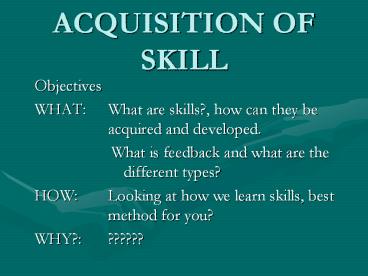ACQUISITION%20OF%20SKILL - PowerPoint PPT Presentation
Title:
ACQUISITION%20OF%20SKILL
Description:
Title: PowerPoint Presentation Last modified by: dboerm Created Date: 1/1/1601 12:00:00 AM Document presentation format: On-screen Show (4:3) Other titles – PowerPoint PPT presentation
Number of Views:93
Avg rating:3.0/5.0
Title: ACQUISITION%20OF%20SKILL
1
ACQUISITION OF SKILL
- Objectives
- WHAT What are skills?, how can they be
acquired and developed. - What is feedback and what are the different
types? - HOW Looking at how we learn skills, best
method for you? - WHY? ??????
2
SKILL
- Skill is using knowledge or expertise to succeed
and effectively in achieving a particular
objective and ability. This has been acquired by
training.
3
THERE ARE TWO TYPES OF SKILL
- BASIC SKILLS
these are usually basic and
straightforward, being able to throw, catch, run,
jump or hit an object. It is important to be able
to do these basic skills easily before attempting
higher levels.
4
- COMPLEX SKILLS
Skills which take a long time to
learn as they involve high levels of
co-ordination and control. - Higher level skills will also be very sport
specific as different sports have skills unique
to them.
5
Types of Skill
- There are 2 types of skills-
- OPEN SKILLS -
- These happen in situations that are
constantly changing such as an invasion game.
Here the game around the player is constantly
changing and skills may have to adapted to meet
the situation.
6
- CLOSED SKILLS -
- These happen in situations which are constant
and unchanging so they are not affected by the
sporting environment. Example a gymnastic
routine. -
7
TYPES OF GUIDANCE
- In order to acquire skill performers often need
further guidance which can take the form of- - VISUAL GUIDANCE seeing a demonstration, example
or even watching their own performance played
back. - VERBAL GUIDANCE being told what needs to be
done or improved constructive criticism. - MANUAL GUIDANCE Performers can be physically
guided through a movement i.e. support in a vault.
8
FEEDBACK
- A performer finds out how good their performance
was through knowledge of results and also
knowledge of performance. The most common ways
are- - INTRINSIC
- This is felt or sensed by the performer when
actually performing. - EXTRINSIC
- This comes from sources other than the performer
themselves i.e. sounds or things they can see.
9
Need to know!
- Knowledge of results this is a form of feedback
at the end of the performance and could be as
simple as winning or losing. - Knowledge of performance this is how the
performance was carried out rather than just the
end result.
10
Types of practice.
- These are ways the performer tries to gain skills
which they have identified that they need - - WHOLE a complete performance is carried out
with all aspects of the performance covered. - PART only specific aspects of the performance
are practiced, such as a specific skill
11
- FIXED a set session or aspect is concentrated
upon. - VARIABLE a combination of all the above































